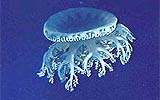Our Great Barrier Reef
Junior Primary Years 1- 3
Sorting Out: Sample Activities
In the earlier activity, students found things using their senses. Ask them to recall things seen, heard, or touched. They share ideas with a partner and draw responses.
At school, brainstorm words and record on a chart. Invite students to illustrate these, then group words on a class chart.
For example:
Things found in the Great Barrier Reef |
 |
| |
|
To see
|
To hear |
To touch |
When seeing the Great Barrier Reef I feel
|
Concept maps
Create a concept map showing what the Great Barrier Reef consists of and then sort and classify descriptions into categories (eg. natural objects and human-made objects).Repeat the activity to illustrate the ways the Great Barrier reef is used for work and recreation.
Classifying information
Students place a picture/name card of an object in the Great Barrier Reef on their chest. They then move around the class to find one or more students with cards that might belong in a group similar to theirs. Students justify their groupings.
What am I?
Play “What am I?”. Each student states something known about the Great Barrier Reef. Record and illustrate responses. Make a class big book.
Six Hat Thinking
Introduce Edward de Bonos’s Six Thinking Hats. Place cut out hats on the floor and group responses as a class.
Red Hat
= feelings
What are my feelings about the Great Barrier Reef?
|
White Hat
= Information
What are some facts we have learned about the Great Barrier Reef? |
Blue Hat
= what thinking is needed
Think of ways to prevent problems developing in the Great Barrier Reef?
|
Green Hat
= new ideas
What is possible for us to do as users of the Great Barrier Reef? |
Black Hat
= weaknesses
What questions or issues does our learning about the Great Barrier Reef raise?
|
Yellow Hat
= strengths
What are the good points we have learned about the Great Barrier Reef? |
Place cut out hats on the floor and group responses as a class.
Use the Blue Hat to determine major areas and focus questions for future investigation.
Class Database
Prepare a wall grid to record information collected by students in future investigations. The left-hand column might indicate names of sections of the Great Barrier Reef eg. Far Northern Section, Cairns Section, Central Section, Mackay Section, or others identified by students.
Columns across the top might indicate the types of information collected and suggested by students, for example:
- Uses of the Great Barrier Reef;
- People who work there;
- People who use it;
- Types of plants;
- Types of animal life;
- Other natural features;
- Special features; and
- Problems or neglected areas.
|

The catamaran "Reef Adventurer II"
entering Heron Island harbour |
| |
|
|
Assessment idea: use checklist to record student contributions to the database. This might include their capacity to suggest categories as well as provide information. This will indicate students’ skill in following a task through to completion and capacity to collect and record information appropriate to the task. |
Family Snapshot
To assist with this activity, ask families to help students complete a survey. Students ask parents about areas of the Great Barrier Reef they have visited including its name, location and features. With the help of family members, students complete Resource 1.4. On another page students draw other activities they and their families might do whilst visiting or working on the Great Barrier Reef to later share with the class.
See Resource 1.4
Graphing
At school students cut up their survey sheets, sort responses and use these to make a class graph of the various activities. Students make statements from the graphed data.
|
Assessment idea.
Ask students to identify:
- The most popular activity;
- The least popular activity; and
- Activities with the same level of popularity.
This will indicate student’s capacity to interpret visual information. |
Categorising Pictures
Using photographs collected during earlier activities, divide them into categories. Ask students:
- Can we put all the photographs in groups? and
- What might we do if some are in more than one group?
Students write or dictate captions for photographs, eg. how people use the area; why the area is so important, etc.
In groups, make a collage, paint a mural or make a class big book.
Modeling
In groups or individually, students construct models of places that are important/significant to them on the Great Barrier Reef. Use plasticine, play |
 |
 |
| Which image does not belong in this group? |
 |
 |
|
dough, construction kits and blocks, and natural materials to make something chosen by the students to show the properties (eg. natural and human-made) and to identify places special to themselves and others.
Display under appropriate labels. Invite other students and/or parents to view and hear about the models.
|
Design a game
In pairs or individually, students design a game matching animals, plants and people to the Great Barrier Reef.
Next - Going Further:
Sample activities |